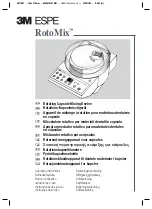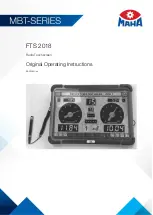
- 12 -
(1)
Temperature Sensor Connector:
Connect the temperature sensor here.
(2)
Dry Point Sensor Connector:
Connect the dry point sensor (option) here.
(3)
Fire Containment Shutter:
Closes to prevent a fire if a flask breaks, a sample catches fire, or
the thermofuse blows.
Do not close when starting a test, thermofuse blows.
(4)
Circulating Water Verification Window:
Allows the user to view the level and status of the
internal circulating solution.
(5)
Heater Door:
Open this door when inserting or removing a flask. Be sure to hold the knob
because the door becomes very hot.
(6)
Heater Height Adjustment Dial:
Raises or lowers the heater unit to set the flask in the correct
location.
(7)
Printer (Option):
Prints distillation data and plots a distillation curve.
(8)
Fire Containment Nitrogen Inlet Port:
Used to discharge nitrogen gas into the heater section
in case of fire. If the nitrogen line is connected, the solenoid valve opens automatically,
similarly to the fire containment shutter, if the thermofuse is blown. The nitrogen gas in
combination with the shutter helps to control fires and prevent the spread of flames.
The size of the inlet port is PT1/4 female, and recommended Nitrogen gas pressure is 500 kPa.
(9)
Heater unit level adjuster:
Can be adjusted to keep the unit level
(10)
LCD display:
Displays various configuration menus, distillation data, distillation curves and
error messages.
(11)
Operating Panel:
Contains START, COOL, RESET and other keys for operating the tester.
Tester settings for each mode can be changed using the keys on this panel.
(12)
Temperature Sensor Holder:
Insert the temperature sensor here during pre-cooling.
(13)
Heater Status Lamp:
Continuously lit during heating, flashing during temperature adjustment.
(14)
Condensation Drain:
Drains condensation pooled in the receiver compartment.
(15)
Manual Fire Containment Shutter Activator:
Press this button to test the fire depressant
shutter. This switch can also be used to manually close the shutter if the shutter fails to close
automatically during a fire.
(16)
RS-232C Connector:
Connect a personal computer with LIMS communication software and
Tanaka's ADManager (option) installed to this communications port.
(17)
Circuit Breaker:
Pops out and cuts power to the tester to protect the circuits if excess current
is detected. To reset, turn the main switch off once, rectify the cause of the current overload,
and press the circuit breaker button.
(18)
Mains Power Switch:
Turns the tester on and off.
(19)
Power Cable Socket:
Connect one end of the power cable to this socket and the other end to
an outlet meeting the specifications.
(20)
Temperature Sensor Rest:
Place the temperature sensor when stand-by.
Summary of Contents for AD-6
Page 2: ...1 Blank Page...
Page 9: ...8 Blank Page...














































